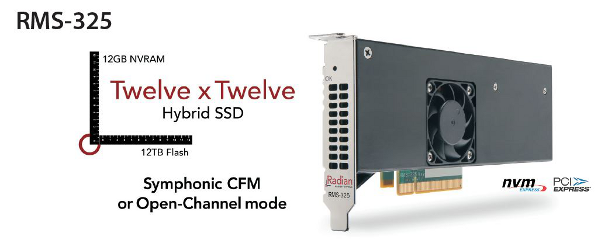Radian Memory Systems, a California-based enterprise technology and device producer, is announcing the industry’s first hybrid NVRAM/Flash solid-state drive (SSD) that combines up to 12GB of user NVRAM with up to 12TB of Flash, all under host control and utilizing either Open-Channel, or Radian’s award-winning Symphonic™ Cooperative Flash Management (CFM) technology.
 The RMS-325 NVRAM/Flash hybrid SSD allows host systems to directly control both its byte-addressable User NVRAM and high capacity Flash storage, as well as transferring data between both types of memory. All required storage and power backup resides on one compact, standard low profile card that requires no external cabling or power packs.
The RMS-325 NVRAM/Flash hybrid SSD allows host systems to directly control both its byte-addressable User NVRAM and high capacity Flash storage, as well as transferring data between both types of memory. All required storage and power backup resides on one compact, standard low profile card that requires no external cabling or power packs.
 The architectural advantages of the RMS-325 hybrid SSD include that it is optimal for efficient tiering of different classes of memory storage and unique advantages over NVDIMMs. Users can scale NVRAM and Flash tiers proportionately as SSDs are added to the system. It offers Special Delegated Move capability to reduce traffic across the system bus, and reduce host overhead. The RMS-325 also simplifies low-latency support for new NVMe-over-Fabric, RDMA/RoCE, and NVMe Direct implementations.
The architectural advantages of the RMS-325 hybrid SSD include that it is optimal for efficient tiering of different classes of memory storage and unique advantages over NVDIMMs. Users can scale NVRAM and Flash tiers proportionately as SSDs are added to the system. It offers Special Delegated Move capability to reduce traffic across the system bus, and reduce host overhead. The RMS-325 also simplifies low-latency support for new NVMe-over-Fabric, RDMA/RoCE, and NVMe Direct implementations.
 Radian’s RMS-325 hybrid SSD is geared toward the most advanced data centers, cloud storage environments featuring virtualization, big data analytics, data warehousing and web services. These environments often utilize software-defined networks, distributed scale-out and/or converged infrastuctures.
Radian’s RMS-325 hybrid SSD is geared toward the most advanced data centers, cloud storage environments featuring virtualization, big data analytics, data warehousing and web services. These environments often utilize software-defined networks, distributed scale-out and/or converged infrastuctures.
 SSDs today utilize a Flash Transition Layer (FTL) as part of their construction, but this FTL can cause expensive overhead, unpredictable latency spikes, and less-than-optimal performance that can cause flash media to wear out prematurely. To deal with this, the RMS-325 provides the option of using either Symphonic Cooperative Flash Management or the Open-Channel mode (Spec. Revision 1.2, April 2016) of flash management to overcome these FTL limitations.
SSDs today utilize a Flash Transition Layer (FTL) as part of their construction, but this FTL can cause expensive overhead, unpredictable latency spikes, and less-than-optimal performance that can cause flash media to wear out prematurely. To deal with this, the RMS-325 provides the option of using either Symphonic Cooperative Flash Management or the Open-Channel mode (Spec. Revision 1.2, April 2016) of flash management to overcome these FTL limitations.
 Hosts offer more intelligence than SSDs when it comes to data and how it should be prioritized and coalesced, as well as scheduling when it should transfer between different memory types. The RMS-325 offers host systems control over up to 12GB of User NVRAM, which allows for more deterministic system-level tiering, and more efficient capacity utilization, which translate to overall reduction of costs.
Hosts offer more intelligence than SSDs when it comes to data and how it should be prioritized and coalesced, as well as scheduling when it should transfer between different memory types. The RMS-325 offers host systems control over up to 12GB of User NVRAM, which allows for more deterministic system-level tiering, and more efficient capacity utilization, which translate to overall reduction of costs.
 Radian’s RMS-325 early access units will be available to select customers in October, and production availability is anticipated for Q1 of 2017. For more information, you can visit the RMS-325 product page here.
Radian’s RMS-325 early access units will be available to select customers in October, and production availability is anticipated for Q1 of 2017. For more information, you can visit the RMS-325 product page here.
 The SSD Review The Worlds Dedicated SSD Education and Review Resource |
The SSD Review The Worlds Dedicated SSD Education and Review Resource | 